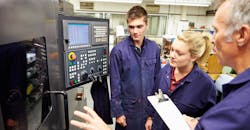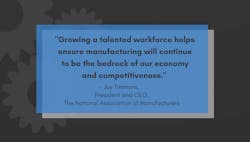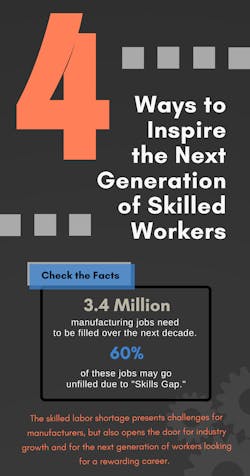It’s no surprise to industry insiders that manufacturing facilities have changed. They are no longer the dark and dirty caverns of the Rust Belt glory days. Today’s factories—at least the ones that have kept reasonable pace with changes in the industry in recent years—are clean, efficient, technology-driven operations built for high performance, high productivity, and high worker satisfaction.
Elements that have made this new breed of manufacturing environment possible include advancements in equipment used on the factory floor, advancements in strategies employed to maintain that equipment, and the Internet of Things (IoT) increasingly being implemented in the industrial arena. Sensors and other types of data acquisition modules, like digital oscilloscopes, have become robust and affordable enough to allow for consistent, accurate monitoring of machine tools.
The employment of these innovations—and the resulting acquisition of valuable data—allows for analysis that enables the effective application of concepts like preventive and predictive maintenance to greatly reduce downtime and increase productivity.
New Technology, New Skills, New Workers
These new types of equipment, technologies, and concepts within the industrial manufacturing environment have led to a shift in the worker skill mix required to make it all happen. This has resulted in one of the biggest challenges in manufacturing today: the skills gap. There is a wave of retiring workers with legacy machine tools and factory floor experience, and their in-depth knowledge of functionality, tendencies, and problem-solving is irreplaceable.
At the same time these workers are retiring, there is a lack of incoming younger workers who are motivated to not only consider the factory environment as a career option (due to long-held negative perceptions) but also to acquire the technology-based skills needed to complement the expertise of still-employed legacy workers.
This skills gap has many manufacturing executives worried. In a recent study, 85% of factory maintenance engineers and executives expressed a profound concern about the retiring factory workforce and the lack of skilled technicians in the younger generation.
It is clear the optimal mix of skills and workers on today’s factory floor is a joint effort: Legacy workers with functional knowledge of machine tools must collaborate with a new breed of younger workers, who have the freshly-ingrained technology savvy required to effectively utilize and maximize today’s advanced equipment and techniques.
To create this optimal mix, smart industrial hiring decision-makers are starting early to seek out potential employees with the right credentials for short-term effectiveness and long-term growth potential.
New Workers, New Credentials
The same study cited above revealed that seven out of 10 respondents see most future manufacturing jobs requiring at least a two-year degree; some even feel a four-year degree will be required in the near future. While that may be an overreaction, as a degree doesn’t necessarily dictate success at many skilled technician-level positions, it is obvious that young workers who display the eagerness and potential to grow into these types of positions are highly desirable.
A degree can be helpful, especially in emerging areas such as mechatronics, which comprises a hybrid of mechanical and electronic skills that apply perfectly to today’s industrial environment, its challenges, and opportunities.
Reaching Out
How does one go about re-crafting and building the right workforce for an industrial manufacturing setting given the trends and challenges described above? Recruiting from technical, vocational, and skills-based schools—as opposed to traditional high schools, where factory work isn’t encouraged as a career path and four-year degrees are stressed—is a good first step.
Reaching out to these young people through partnerships with the right types of technical education entities allows decision-makers to enlighten young people about the new factory environment, including all of the excitement and potential for development that offers them.
Another opportunity for recruitment comes by finding those workers—some with low-income or displacement status looking for retraining—who have sought out government and educational grants or internships to jumpstart or further their working life, despite disadvantaged backgrounds.
Employee Development
Once the right young workers are recruited and hired, ongoing development of these individuals is key. Continuous training, optimally a multi-pronged approach that includes hands-on learning, classroom training, and online resources, is a great way to provide comprehensive knowledge transfer.
Highly important too is ingraining a mentorship mentality within your organization. Again, the collaboration between legacy workers and new young talent is a key component for staffing success. Pairing those workers through a mentorship program is invaluable in producing optimal effectiveness, job satisfaction, and retention in all workers, which keeps productivity high and costs low in the long run.
Millennial Mentality
While an influx of the right younger workers is a big part of the goal, it’s one that comes with challenges. It must be understood that these workers are vastly different in terms of work styles and motivations than legacy workers with many years of experience.
Decision-makers and managers must become familiar with and effective in directing and developing young workers by understanding the “millennial mentality.” While legacy workers may be used to and loyal to following tasks and routines because they have been ingrained for many years, younger workers seek to understand why things are done the way they are, and may question old ways while offering interesting new alternatives.
In terms of motivation and reward, legacy workers are more likely to be satisfied with modest advancements every few years; younger workers are used to reaching milestones—personal and career alike—within much shorter timeframes. They expect recognition and rewards for a job well done to come quickly so the feeling of momentum is strong and consistent. Smart managers will recognize this and implement programs for motivation, advancement, and rewards that accommodate the expectations of these younger workers, therefore breeding satisfaction and retention.
It may seem a bit confusing and tedious at first, but the new energy injected into the organization by these workers, who have been developed in the right way, is well worth the effort to the entire organization in the long run as the industry continues to advance.
Chris Hobbs has more than 25 years of manufacturing and industrial experience. He is currently the manager of technical training at ATS, where he oversees the SkillPoint Training program comprising hands-on and online courses for maintenance technicians to improve their skillsets.



